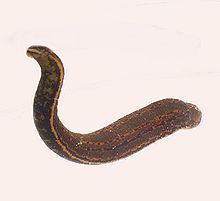Leeches
| Leech Temporal range: Silurian–Recent |
|
|---|---|
 |
|
| Hirudo medicinalis | |
 |
|
| Scientific classification | |
| Kingdom: | Animalia |
| Phylum: | Annelida |
| Class: | Clitellata |
| Subclass: |
Hirudinea Lamarck, 1818 |
| Infraclasses | |
|
Acanthobdellidea |
|
Acanthobdellidea
Euhirudinea
(but see below)
Leeches are segmented worms that belong to the phylum Annelida and comprise the subclass Hirudinea. Like the oligochaetes, such as earthworms, leeches share a clitellum and are hermaphrodites. Nevertheless, they differ from the oligochaetes in significant ways. For example, leeches do not have bristles and the external segmentation of their bodies does not correspond with the internal segmentation of their organs. Their bodies are much more solid as the spaces in their coelom are dense with connective tissues. They also have two suckers, one at each end.
The majority of leeches live in freshwater environments, while some species can be found in terrestrial and marine environments. The best-known leeches, such as the medicinal leech, Hirudo medicinalis, are hematophagous, feeding on vertebrate blood and invertebrate hemolymph. Most leech species, however, are predatory, feeding primarily by swallowing other invertebrates. Almost 700 species of leeches are currently recognized, of which some 100 are marine, 90 terrestrial and the remainder freshwater taxa.
Leeches, such as the Hirudo medicinalis, have been historically used in medicine to remove blood from patients. The practice of leeching can be traced to ancient India and Greece, and continued well into the 18th and 19th centuries in both Europe and North America. In modern times, leeches are used medically in procedures such as the reattachment of body parts and reconstructive and plastic surgeries and, in Germany, treating osteoarthritis.
Leeches are presumed to have evolved from certain Oligochaeta, most of which feed on detritus. However, some species in the Lumbriculidae are predatory and have similar adaptations as found in leeches. As a consequence, the systematics and taxonomy of leeches is in need of review. While leeches form a clade, the remaining oligochaetes are not their sister taxon, but in a diverse paraphyletic group containing some lineages that are closely related to leeches, and others that are far more distant.
...
Wikipedia
